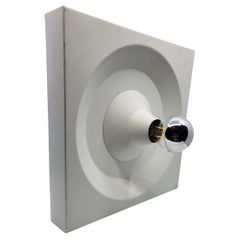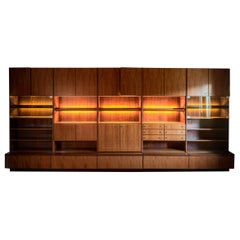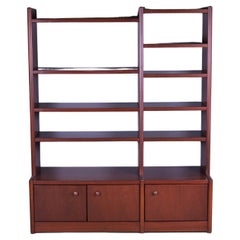Vintage Hulsta Furniture
1960s German Futurist Vintage Hulsta Furniture
Metal
Recent Sales
Late 20th Century Vintage Hulsta Furniture
Glass, Rosewood
1990s German Modern Vintage Hulsta Furniture
Mahogany
1990s German Mid-Century Modern Vintage Hulsta Furniture
Mahogany
Mid-20th Century Dutch Mid-Century Modern Vintage Hulsta Furniture
Aluminum
Finding the Right storage-case-pieces for You
Of all the antique and vintage case pieces and storage cabinets that have become popular in modern interiors over the years, dressers, credenzas and cabinets have long been home staples, perfect for routine storage or protection of personal items.
In the mid-19th century, cabinetmakers would mimic styles originating in the Louis XIV, Louis XV and Louis XVI eras for their dressers, bookshelves and other structures, and, later, simpler, streamlined wood designs allowed these “case pieces” or “case goods” — any furnishing that is unupholstered and has some semblance of a storage component — to blend into the background of any interior.
Mid-century modern furniture enthusiasts will cite the tall modular wall units crafted in teak and other sought-after woods of the era by the likes of George Nelson, Poul Cadovius and Finn Juhl. For these highly customizable furnishings, designers of the day delivered an alternative to big, heavy bookcases by considering the use of space — and, in particular, walls — in new and innovative ways. Mid-century modern credenzas, which, long and low, evolved from tables that were built as early as the 14th century in Italy, typically have no legs or very short legs and have grown in popularity as an alluring storage option over time.
Although the name immediately invokes images of clothing, dressers were initially created in Europe for a much different purpose. This furnishing was initially a flat-surfaced, low-profile side table equipped with a few drawers — a common fixture used to dress and prepare meats in English kitchens throughout the Tudor period. The drawers served as perfect utensil storage. It wasn’t until the design made its way to North America that it became enlarged and equipped with enough space to hold clothing and cosmetics. The very history of storage case pieces is a testament to their versatility and well-earned place in any room.
In the spirit of positioning your case goods center stage, decluttering can now be design-minded.
A contemporary case piece with open shelving and painted wood details can prove functional as a storage unit as easily as it can a room divider. Whether you’re seeking a playful sideboard made of colored glass and metals, an antique Italian hand-carved storage cabinet or a glass-door vitrine to store and show off your collectibles, there are options for you on 1stDibs.
- How old is vintage furniture?1 Answer1stDibs ExpertAugust 15, 2019
A piece of furniture must be at least 20 years old to be considered vintage.
- 1stDibs ExpertMay 3, 2024To know if your Drexel furniture is vintage, examine its serial number, which you will usually find in a hidden spot, such as beneath a tabletop or on the back or bottom of a casegood. By cross-referencing this number with information available on trusted online resources, you should be able to estimate the year of production. Drexel furniture produced more than 20 years ago would qualify as vintage. If you need assistance with dating your piece, seek the advice of a certified appraiser or knowledgeable antiques dealer. On 1stDibs, find a diverse assortment of Drexel furniture.
- 1stDibs ExpertApril 5, 2022The first step in determining if an item is vintage bamboo is to first make sure it’s bamboo. Bamboo is inflexible, so if there are curved shapes in the design it is actually rattan, not bamboo. Your next step is to understand the style of the piece of furniture, the brand, and look for telltale signs that it is an authentic piece from that brand. Shop a range of antique and modern bamboo furniture on 1stDibs.
- 1stDibs ExpertMay 3, 2024To identify vintage Woodard patio furniture, look for the maker's markings. On three-piece sets, you'll typically find paper labels that bear the brand name underneath the cushions. Sofa and chair frames may also feature welded-on metal labels bearing the brand name. For wrought iron pieces, check the frame for an embossed "Woodard" mark. Once you find the markings, you can use trusted online resources to determine a rough idea of the age of your piece. Anything produced more than 20 years ago, but less than a century ago, is vintage. Pieces more than 100 years old are antique, while those made within the last two decades are contemporary. If you're unable to locate any markings, a certified appraiser or knowledgeable antiques dealer can assist you with identification and dating. On 1stDibs, explore an assortment of Woodard furniture.
- 1stDibs ExpertJanuary 25, 2019
The difference between vintage and antique furniture is that vintage furniture is at least 20 years old, while antiques must be at least 100 years old to be considered antique.
Read More
The Ultimate Guide to Types of Tables for the Home
Whether you’re just moving in or ready to give your home a makeover, our guide will give you pointers on tables that are fitting for every room, nook and hallway.
What Exactly Is a Secretary Desk, and What Is It Used For?
The furniture equivalent of a Swiss Army knife, it's the multifunctional piece you didn't know you needed.
This Shelving System with Oxidized Brass Tubes Is Retro and Futuristic at Once
Italian studio DimoreMilano mustered great ingenuity when crafting these sculptural shelves, which are built without any screws.
28 Cheerful Home Bars, Where Everybody (Literally) Knows Your Name
Simple or sophisticated, equipped with console, cart or custom cabinetry, these stylish bar areas deserve a toast.
Ask an Interior Designer: Work-from-Home Edition
Leaping into a design project, whether it's refreshing the bedroom or redoing the whole house, can be overwhelming. Luckily, we know more than a few interior designers. You asked questions on Instagram, and now they're answering.
Collected and Eclectic, ‘Wunderkammern’ Are Back in a Big Way
Introduced nearly 500 years ago, curiosity cabinets are finding new fans among today's collectors and designers.
Meet the Incredible Woman Transforming Fallen Trees into Sleek Furniture
In the hands of New York Heartwoods cofounder Megan Offner, unwanted local trees become works of design art.
These New York Architects Love a Complicated Project
From Brooklyn townhouses to Maine campgrounds, Trattie Davies and Jonathan Toews relish a challenge, like transforming a former warehouse space into the new 1stdibs Gallery.


